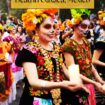
We are reader-supported and may earn a commission on purchases made through links in this article.
The paintbrush in Rosario’s hand dripped bright red, and I winced as she moved in close to my face during the Day of the Dead celebration in Oaxaca, Mexico.
I could feel the cold liquid sweep across my eyelid, under my eye and around it. I had no clue how this ‘makeover’ would turn out.
It would cost me only 75 pesos, (US$ 3.50) but it had to be finished before our nighttime visit to the cemetery in Xoxocotlan outside of Oaxaca. I had requested ‘Medio’- the one-sided face-painting option because it signified honor to both the living and the dead.
The cosmetic artist grabbed large fake, diamond-like rounds and pushed them into place around my eye.
Day of the Dead
A brush that oozed in harsh black paint zeroed in to coat my nose. A few more strokes and Rosario stood back to admire her work on my calavera face.
As I looked at the mirrored image of half a skull, with colorful facial decoration over white-based skin for the Dia de los Muertos event, ideas of how to blast the paint off at night’s end festered in my mind.
Best Tips & Tools to Plan Your Trip
Next, my husband nervously prepared for his facial transformation into a catrin, the male version of a catrina, a human figure in skeletal form, seen at every turn during Day of the Dead.
In the early 20th century, Mexican political cartoonist Jose’ Guadalupe Posada created a series of skeleton caricatures, known as Posada’s Calaveras and Catrinas to mock rich Mexican socialites.
“Todos somos calaveras,” he said. “We are all skeletons−underneath man-made trappings, we are all the same.”
Day of the Dead Traditions
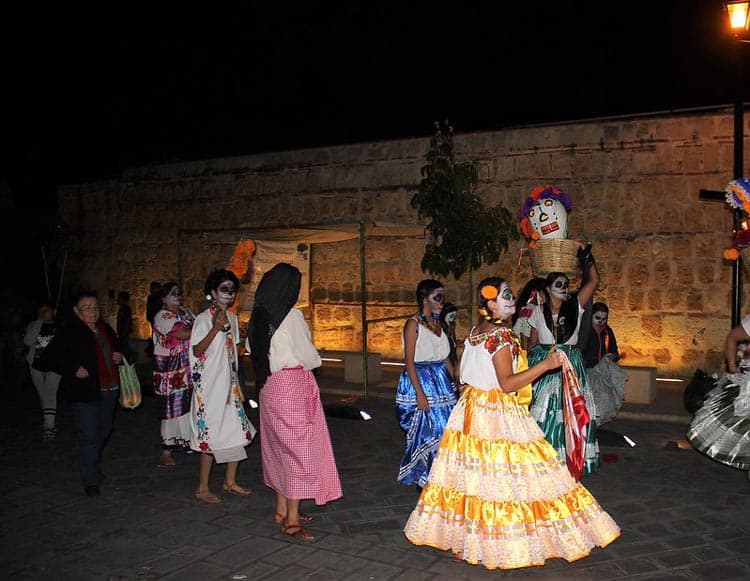
What is the Day of the Dead (Día de los Muertos)? It’s a multi-day Mexican holiday when people honor their friends and family who have died with prayers and remembrances.
In 1948, Mexican artist Diego Rivera painted a calavera-faced woman representing his wife, Frida Kahlo, dressed in fancy clothes and furs in his iconic mural, Dream of a Sunday Afternoon in Alameda Park. This image of death, la catrina, became the most universal symbol of Mexico’s Day of the Dead celebration.
The pockets of Rosario’s smock bulged with 100 peso bills. At her annual ‘money making’ event, she had to create ‘dead-faces’ non-stop during the three-day affair. Come November 3rd, her cash flow would dry up quicker than her paint brushes.
Tourists, eager to interact with mourners who sat vigil from midnight until daybreak at the grave sites of their departed relatives, hoped the Mexican families might accept the foreigners’ intrusion if they looked the part.
Even though we live in Mexico as expatriates, we joined the throngs who had come to observe the Mexican Dia de los Muertos and photograph the locals’ preparation for the return of dead souls.
Infringe upon each family’s personal space around the grave sites and with no harmful intent, disturb the faithful with our gawking.
Visiting Mexico During Day of the Dead
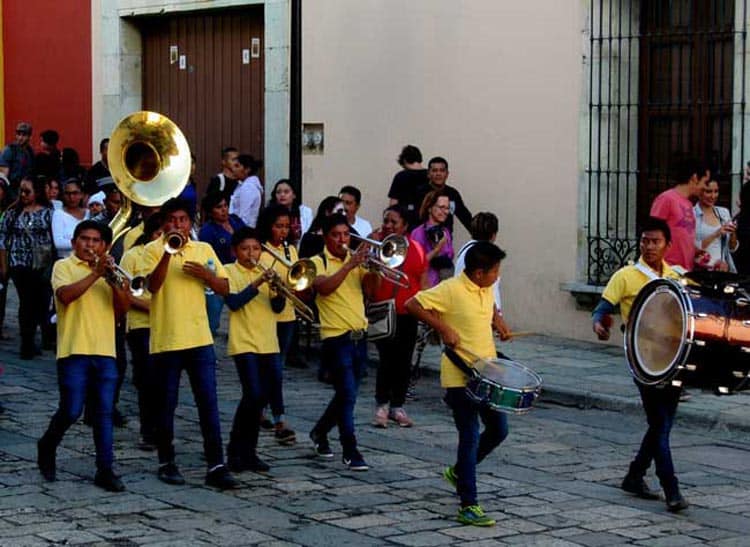
You’ll need to start planning now if you want to visit during the Day of the Dead. Annual Day of the Dead observation in Oaxaca, Mexico from Oct. 31 to Nov. 2 attracts the largest number of world-wide visitors.
It’s a mixture of pre-Hispanic celebration of Death and the Catholic feast of All Saints Day on Nov. 1 and All Souls Day on Nov. 2.
Other cities throughout the country follow the traditions, but travelers who have selected Oaxaca should expect hordes of companions, both living and dead.
Since the 2018 Academy Award-winning animated film, Coco by Pixar Studios, revealed the story of Oaxaca’s Dia de los Muertos, the number of tourists to this year’s event quadrupled.
Every flight was overbooked, and anyone without reserved accommodations could be seen dragging suitcases looking for a room.
La Casona Oaxaca
In our boutique hotel, La Casona Oaxaca, a block from the central square, we met travelers from China, Thailand, Japan and in-country voyeurs such as ourselves from Guadalajara.
Local Mexican mourners have accepted the blitz of foreign spectators. Their sacrifice of privacy has led to a peso-rich explosion of the region’s economy, with the infusion of millions of tourist dollars pouring into the city.
Onlookers spare no expense to participate in events at cemeteries throughout the area and enjoy repasts of Oaxaca delicacies like pollo mole in Central Plaza upscale restaurants.
Banners of wild orange and pink cut-out tissue paper called papel picado crisscrossed all the streets and the intoxicating aroma of copal incense filled the air. It was a bright, colorful, exciting party at every turn.
Dia de los Muertos
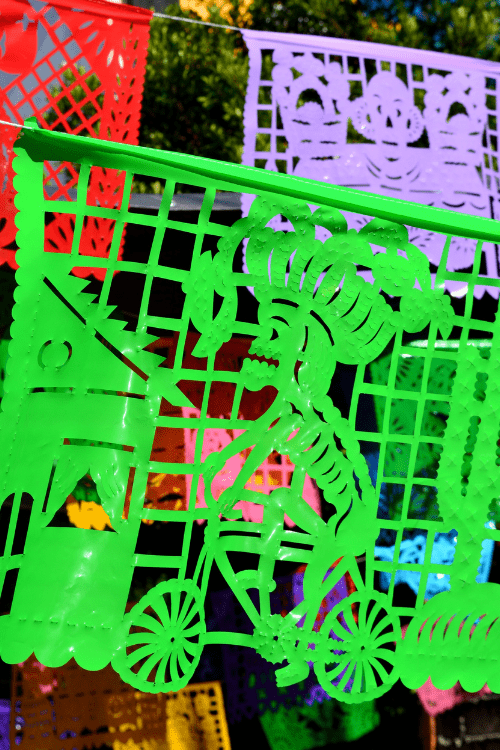
As I watched eager cemeterygoers wait for a proper painted face, I couldn’t help comparing this festive bash to our 2015 experience of the Day of Dead celebration in Patzquaro in Mexico’s state of Michoacán.
Calavera painted-faces missing, reverent, somber and respectful reflections took place at graveyards located on many of the remote islands situated on Lake Patzquaro.
Every year, indigenous people from the surrounding countryside travel to the lake’s shores, pile into canoes and paddle to isolated islands where their loved ones are buried.
We stopped briefly at Janitzio, the largest and closest island to shore which resembled Oaxaca with its commercialization. Tourists swigged tequila, crowded the main street leading to the cemetery, and danced to live music along the way.
Dizzied by the pandemonium, we sped away across the lake to a tiny, sparsely populated island, an hour’s boat ride away.
Upon docking at the isle’s pier, we climbed steep steps to the entrance of the sacred graveyard where the faithful pushed wheelbarrows full of adornments. I loved sitting with families around well-prepared resting places from midnight until 4 am.
A cold mist rose eerily from the lake into the dark November night sky and bundled relatives huddled together on blankets covering the hard, damp earth.
Observers numbered an inconspicuous 30. We brought offerings of candles and pan de muertos, round sweet breads made especially to help lure the souls back home. A vegetable-based painted calavera, called a carita had been baked in the bread’s center and it is this icon that authenticates every loaf.
We shared the pan with families and listened to their stories told in Spanish about the persons whose spirits they awaited. I remembered the intimacy I felt with the mourners and the mystical connection to Mexico’s unique interpretation of death.
Day of the Dead Celebrations
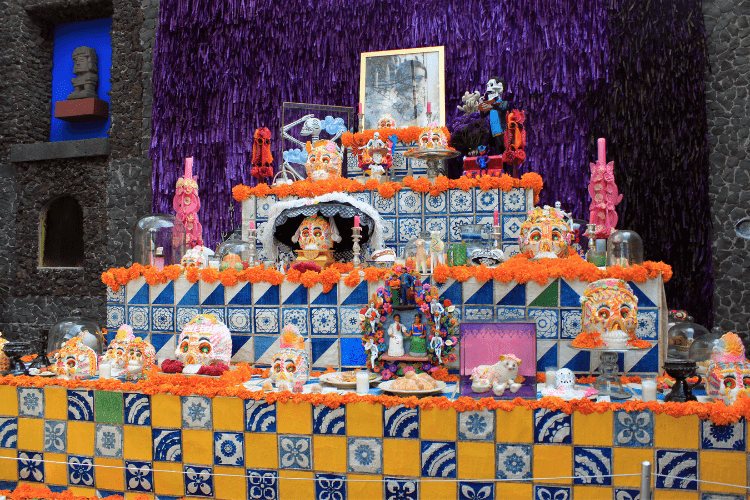
The sound of a brass band jolted my attention back to the crazy, loud revelry of Oaxaca’s rendition of Day of the Dead. The Central Plaza remained the focal point for non-stop activity throughout the three days.
From 9 am until midnight, parades called calendas, lined with comparsas, the name given to costumed children, teens, and adults, all wearing calavera-painted faces followed small enclaves of trumpeters, trombonists and drummers around the square.
Each time we heard toots of horns, we’d rush to that corner to see the stilt-walkers, huge balloon carriers, large puppets, street dancers and Oaxaca residents embracing their celebration.
Vendors set up stands throughout the central area, selling painted carved skulls made of wood or hardened sugar called calacas for additional adornments on the graves. Bright yellow and orange marigolds, cempasuchiltes, lined the flower beds around the square, making the entire area glow in a bath of warm hues.
The marigolds represent the aura that acts as a beacon to guide the souls back to their burial plots and every gravesite overflows with bunches of them, along with magenta, brush-like cockscombs.
Dedications to the Deceased
Intricately detailed public altars, requiring intense labor to construct, popped up throughout Oaxaca City.
Dedicated to important deceased leaders and community dignitaries, the altars made of thousands of bright flowers, candles and calaveras delighted tourists ambling about on the traffic banned streets.
Mesmerized by the process, I watched with fascination as young Oaxaca students completed an enormous altar dedicated to missed professors.
Residents of most Mexican communities that celebrate Day of the Dead erect private altars in their homes, decorated with personal effects of those being remembered, but in Oaxaca, the public displays capture the interest of the masses.
An endless stream of cars, taxis, vans, buses, motorcycles, and primitive carts hanging together with nuts and bolts clogged the road to the cemetery at Xoxocotlan. Entangled in this moving mass of metal, we inched along. A 20-minute trip turned into two hours and parking became a challenge.
Festivities and Baked Goods
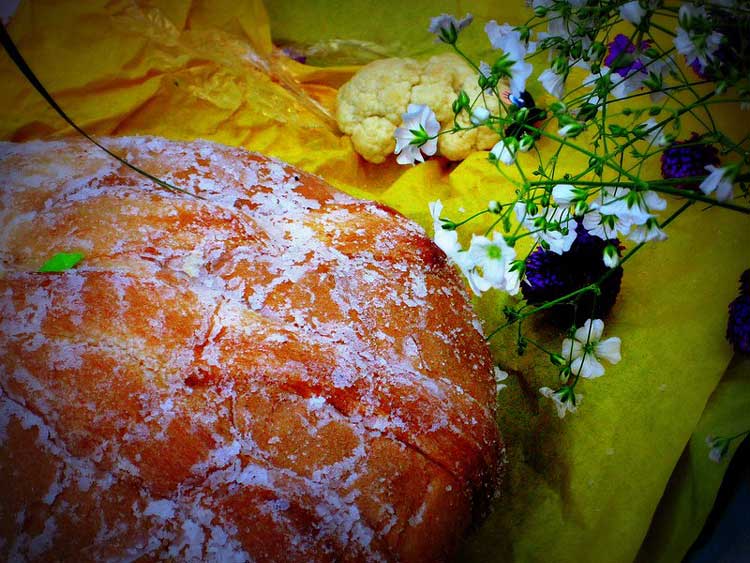
We happily walked a half mile in the frosty evening to the panteὀn, carrying offerings of wilted marigolds, a loaf of pan de muertos and votive candles.
We held onto our excitement of the experience, despite the thousands who came for the same reason. A rock band played loud, Mexican music outside the entrance.
Inside we shuffled along the conveyor belt of humans moving through the concrete aisles between the tombstones. Bakers selling everything from food to fireworks created pockets of chaos among the confusion.
Many of the grave sites were elaborately, fashioned with flowers, favorite food of the departed and candles to brighten the way home for the souls. Families sat on chairs around the sacred mounds, toasting with tequila or corn-mash pulque.
A grave, with scant decorations and a single female mourner by its side, caught my attention. I laid my bundle of meager offerings on the newly overturned earth. She touched my hand and whispered “Gracias.”
Night for the Living
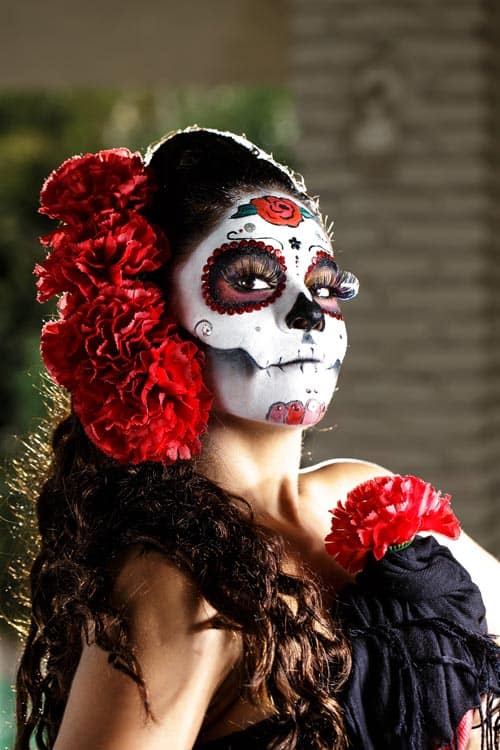
Our goal here had been achieved. As midnight approached, we squeaked through openings in the throngs of oncoming crowds toward the exit. It was time to move on to the oldest cemetery in the Oaxaca area, Atzompa, a tiny village on the outskirts of the city.
Leaving the ‘big tourist draw’ happened to be our godsend as we left the hordes behind. Vendors selling cempasuchitles along the road guided the way.
A distinctly different Day of the Dead atmosphere unfolded. Definitely a graveyard rather than cemetery, this ancient panteὀn viejo in Atzompa had no squared-off rows.
Tombstones dotted the area in a haphazard, dig where there’s space, pattern. Of course, a smidge of raucousness was required, as a band prepared their instruments on the cemetery’s fringe and a neon-lighted, miniature Ferris wheel planted in between two mounds entertained the children.
Meter-high candles lined each grave site. As I squeezed passed side-by-side graves, the fear of catching on fire gave me more fright than the eerie feeling of the night.
The aura of this ancient site felt magical, hallowed, and strangely alive with the very souls expected to return. I loved the atmosphere and the energy of the families guarding their precious ground.
Whether the choice is the festive party or the quiet, reverent tribute to the dead, there can be no other suggestion than to choose one and to go and experience it. Mexico’s Day of the Dead celebration is really a Night for the Living and these Mexican souls live it to the fullest.
If You Go
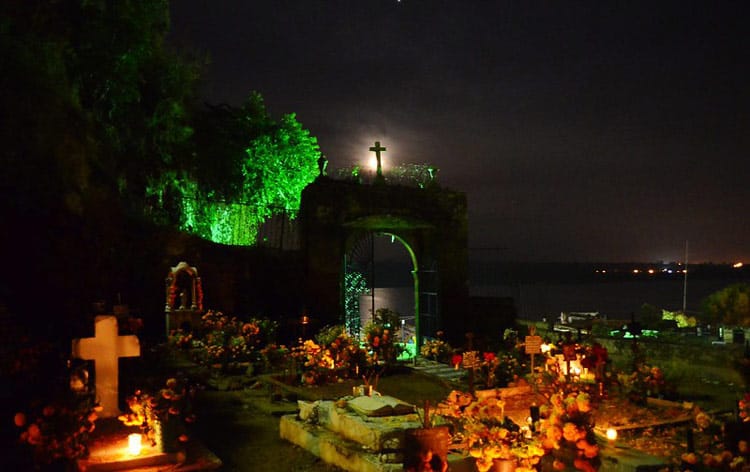
If Day of the Dead observation anywhere in Mexico is on your bucket list, make flight and hotel reservations at least six months in advance. Nine months is preferable if you want to be able to stay near the square in Oaxaca where the action unfolds and excitement stirs.
Small boutique inns will arrange group excursions to the cemeteries on any of the three nights, Oct. 31- Nov. 2. Our hotel, La Casona had arranged transportation for 12 guests to travel together to the cemeteries.
Otherwise, tour guides roam about the square and offer packages to visit Day of the Dead events which can be booked on the spot. Outside the city, points of interest abound. Visits to the ruins of Monte Alban archaeological site, center of 8th century Zapotec and Mixtec culture, can be arranged by tour or by public bus or taxi.
Villages surrounding Oaxaca, each concentrating on only one artisan craft, provide days of wonder and education as tourists can observe the art of weaving rugs in Teotitlan del Valle, the process of producing black pottery in San Bartolo Coyotepec, or the magic of the public market in Ocotlan.
Public buses can be taken to each town, or tours can be arranged to take in as many sites as one wishes to visit.
For booking accommodations in Oaxaca, check:
Read More:
Author’s Bio: After a life-long profession of treating the mentally ill at a PA psychiatric hospital for 33 years and also serving as its Director of Admissions, Carol retired to Lake Chapala, Mexico in 2006 with her husband, to pursue more positive passions. Her family thought that she, too, had ‘gone mad.’ She’s been teaching English to Mexican adults for ten years, in a program operated by volunteer expatriates and writing for local on-line and print publications. Using her adventures experienced during visits to over 80 countries to capture a niche in travel writing, Carol also dabbles in ‘memoir.’ A frequent contributor to Lake Chapala English magazine, “El Ojo del Lago,” she’s won several literary awards from that publication, including Best Feature in 2010 and Best Fiction in 2014. She also netted a story regarding her psychiatric fieldwork in the published anthology, “Tales from the Couch.”
- Why the Kimberley Should Be Your Next Australian Adventure - July 5, 2025
- How We Finally Afforded Our Dream Trip to the Swiss Alps (And You Can Too) - July 5, 2025
- Escape Manhattan for Governors Island - July 5, 2025

